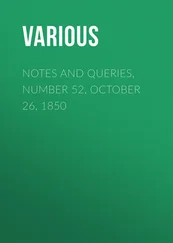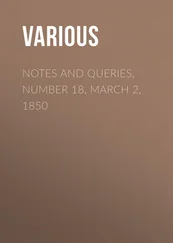Various - Notes and Queries, Number 58, December 7, 1850
Здесь есть возможность читать онлайн «Various - Notes and Queries, Number 58, December 7, 1850» — ознакомительный отрывок электронной книги совершенно бесплатно, а после прочтения отрывка купить полную версию. В некоторых случаях можно слушать аудио, скачать через торрент в формате fb2 и присутствует краткое содержание. Жанр: foreign_antique, periodic, foreign_edu, на английском языке. Описание произведения, (предисловие) а так же отзывы посетителей доступны на портале библиотеки ЛибКат.
- Название:Notes and Queries, Number 58, December 7, 1850
- Автор:
- Жанр:
- Год:неизвестен
- ISBN:нет данных
- Рейтинг книги:3 / 5. Голосов: 1
-
Избранное:Добавить в избранное
- Отзывы:
-
Ваша оценка:
- 60
- 1
- 2
- 3
- 4
- 5
Notes and Queries, Number 58, December 7, 1850: краткое содержание, описание и аннотация
Предлагаем к чтению аннотацию, описание, краткое содержание или предисловие (зависит от того, что написал сам автор книги «Notes and Queries, Number 58, December 7, 1850»). Если вы не нашли необходимую информацию о книге — напишите в комментариях, мы постараемся отыскать её.
Notes and Queries, Number 58, December 7, 1850 — читать онлайн ознакомительный отрывок
Ниже представлен текст книги, разбитый по страницам. Система сохранения места последней прочитанной страницы, позволяет с удобством читать онлайн бесплатно книгу «Notes and Queries, Number 58, December 7, 1850», без необходимости каждый раз заново искать на чём Вы остановились. Поставьте закладку, и сможете в любой момент перейти на страницу, на которой закончили чтение.
Интервал:
Закладка:
Various
Notes and Queries, Number 58, December 7, 1850 / A Medium of Inter-communication for Literary Men, Artists, Antiquaries, Genealogists, etc
NOTES
FURTHER NOTES ON THE HIPPOPOTAMUS
The following remarks are supplementary to a note on the hippopotamus in Vol. ii, p. 35. In that note the exhibition of the hippopotamus at the Roman games is not traced lower than the time of the Emperor Commodus. Helagabalus, however, 218-22 A.D., had hippopotami among the various rare animals which he displayed in public as a part of his state. (Lamprid. c. 28) A hippopotamus was likewise in the vast collection of animals which were prepared for the Persian triumph of Gordian III., but were exhibited at the secular games celebrated by the Emperor Philip in the 1000th year of Rome, 248 A.D. ( Capitol. in Gordian. Tert ., c. 33.) In the seventh eclogue of Calpurnius, a countryman describes the animals which he saw in the Roman amphitheatre, among which is the hippopotamus:
"Non solum nobis silvestria cernere monstra
Contigit; æquoreos ego cum certantibus ursis
Spectavi vitulos, et equorum nomine dignum,
Sed deforme genus, quod in illo nascitur amni
Qui sata riparum venientibus irrigat undis."
Calpurnius is generally referred to the time of Carus and Numerian, about 283 A.D.; but his date is not determined by any satisfactory proof. (See Dr. Smith's Dict. of Ancient Biog. and Myth . in v.)
There is no trace of a live hippopotamus having been brought to Europe between the time specified in the last of these testimonies and the middle of the sixteenth century. When Belon visited Constantinople, he saw there a living hippopotamus, which had been brought from the Nile:
"L'animal que j'ai veu vivant à Constantinople (he says), apporté du Nil, convenoit en toutes marques avec ceulx qu'on voit gravez en diverses medales des Empereurs."— Observations , liv. ii. c. 32. fol. 103. b. ed. 1564.
Belon returned to Paris from the Levant in the year 1550. In his work on fishes, p. 17., he speaks of another Frenchman, lately returned from Constantinople, who had seen the same animal. (See Schneider on Artedi Synonym. Piscium , p. 267.) P. Gillius likewise, who visited Constantinople in 1550, saw there the same hippopotamus, as he states in his description of the elephant, Hamburg, 114. (Schneider, Ib. p. 316.)
Your correspondent, Mr. G. S. Jackson (Vol. ii., p. 277.) controverts the opinion expressed in my former note, that none of the Greek writers had seen a live hippopotamus. He thinks that "Herodotus's way of speaking would seem to show that he was describing from his own observation;" and he infers that the animal was found at that time as far north as the Delta, from the fact, mentioned by Herodotus, of its being held sacred in the nome of Papremis. But, in the first place, it does not follow that, because the hippopotamus was held sacred in the Papremitic nome, it was found in the Nile as low as that district. In the next place, there is nothing in the words of Herodotus to indicate that he had seen the object of his description. (ii. 71.) On the other hand, the substance of his description tends strongly to the inference that he had not seen the animal. It is difficult to conceive that any eye-witness could have described a hippopotamus as having the hoofs of an ox, with the mane and tail of a horse. His information as to javelins being made of its skin was doubtless correct, and he may perhaps have seen some of these weapons. Cuvier conjectures that the original author of the description in Herodotus had seen only the teeth and some part of the skin of the real hippopotamus; but that the other particulars were taken from a figure or description of the gnu ( Trad. de Pline , tom. vi. p. 444.) This supposition is improbable, for the gnu is an animal of Southern Africa, and was doubtless unknown to the Egyptians in the time of Herodotus. Moreover, Cuvier is in error as to the statement of Herodotus respecting the animal's size: he says that the animal is equal in size, not to an ass, but to the largest ox. The statement as to the ass is to be found in Arist. Hist. An. , ii. 7. Cuvier's note is hastily written; for he says that Diodorus describes the hippopotamus as equalling the strongest bulls,—a statement not to be found in Diodorus. (i. 35.) His judgment, however, is clear, as to the point that none of the ancient naturalists described the hippopotamus from autopsy. The writer of the accurate history of the hippopotamus in the Penny Cyclopædia , vol. xii. p. 247., likewise takes the same view. If Achilles Tatius is correct in stating that "the horse of the Nile" was the native Egyptian name of the animal, it is probable that the resemblance to the horse indicated in the description of Herodotus, was supplied by the imagination of some informant.
In the mosaic of Palestrina (see Barthelemy in Mém. de l'Acad. des Inscript. , tom. xxx. p. 503.), the hippopotamus appears three times in the lower part of the composition, at the left-hand corner. Two entire figures are represented, and one head of an animal sinking into the river. Men in a boat are throwing darts at them, some of which are sticking in their backs. (See Ib. p. 521.) Diodorus (i. 35.) describes the hippopotamus as being harpooned, and caught in a manner similar to the whale. Barthelemy properly rejects the supposition that the mosaic of Palestrina is the one alluded to by Pliny ( Hist. Nat. xxxvi. 64.) as having been constructed by Sylla. He places it in the time of Hadrian, and supposes it to represent a district of Upper Egypt, with which the introduction of the hippopotamus well accords. The true form of the hippopotamus was unknown in Italy in the time of Sylla.
The word ἱπποπόταμος as used by the Latin writers, instead of ἵππος ποτάμιος occurs in Lucian ( Rhet. Præcept. , c. 6.). The author of the Cynegetica , who addresses his poem to the Emperor Caracalla, describes the hippopotamus under the name of ἵππαγρος, "the wild horse," compounded like ὄναγρος (iii. 251-61.). In this passage the old error as to the cloven hoofs and the mane is repeated. It is added that the animal will not endure captivity; but if any one is snared by means of ropes, he refuses to eat or drink. That this latter statement is fabulous, is proved by the hippopotamus taken alive to Constantinople, and by the very tame animal now in the Zoological Garden.
The fable about the hippopotamus destroying its father and violating its mother, cited before from Damascius, is to be found in Plutarch, De Solert. Anim. , c. 4. Pausan. (viii. 46. § 4.) mentions a Greek statue, in which the face was made of the teeth of the hippopotamus instead of ivory.
An interesting account of the younger hippopotamus in the Zoological Garden, by Professor Owen, may be seen in the Annals and Magazine of Natural History for June last.
L.PARALLEL PASSAGES: COLERIDGE, HOOKER, BUTLER
I do not remember to have seen the following parallels pointed out.
Coleridge. The Nightingale. A conversation poem:
"The nightingale—
'Most musical, most melancholy' bird!
A melancholy bird! Oh! idle thought!
In nature there is nothing melancholy.
But some night-wandering man whose heart was pierced
With the remembrance of a grievous wrong,
. . . . he, and such as he,
First named these notes a melancholy strain."
Plato Phædo, § 77. (p. 85., Steph.):
"Men, because they fear death themselves, slander the swans, and say that they sing from pain lamenting their death, and do not consider that no bird sings when hungry, or cold, or suffering any other pain; no, not even the nightingale, and the swallow, and the hoopoe, which you know are said to sing for grief," &c.
Читать дальшеИнтервал:
Закладка:
Похожие книги на «Notes and Queries, Number 58, December 7, 1850»
Представляем Вашему вниманию похожие книги на «Notes and Queries, Number 58, December 7, 1850» списком для выбора. Мы отобрали схожую по названию и смыслу литературу в надежде предоставить читателям больше вариантов отыскать новые, интересные, ещё непрочитанные произведения.
Обсуждение, отзывы о книге «Notes and Queries, Number 58, December 7, 1850» и просто собственные мнения читателей. Оставьте ваши комментарии, напишите, что Вы думаете о произведении, его смысле или главных героях. Укажите что конкретно понравилось, а что нет, и почему Вы так считаете.












